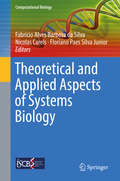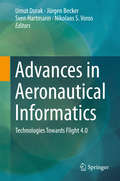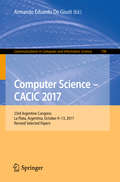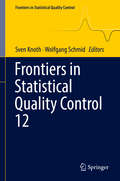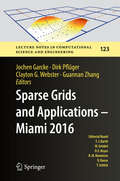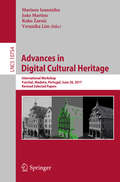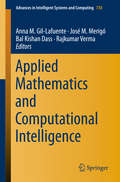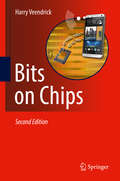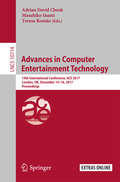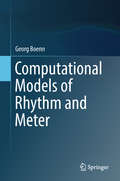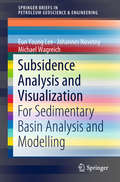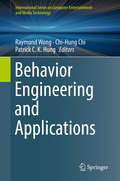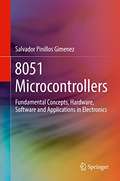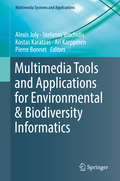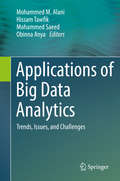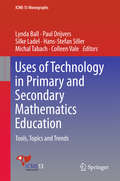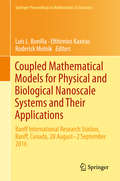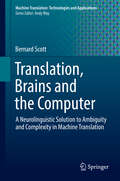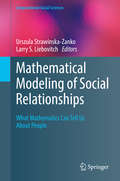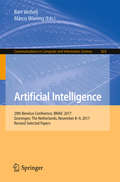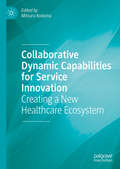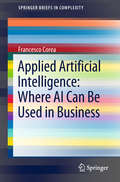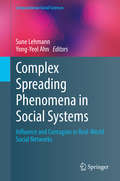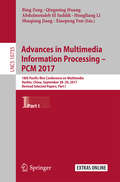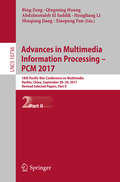- Table View
- List View
Theoretical and Applied Aspects of Systems Biology (Computational Biology #27)
by Fabricio Alves Barbosa da Silva Nicolas Carels Floriano Paes Silva JuniorThis book presents the theoretical foundations of Systems Biology, as well as its application in studies on human hosts, pathogens and associated diseases. This book presents several chapters written by renowned experts in the field. Some topics discussed in depth in this book include: computational modeling of multiresistant bacteria, systems biology of cancer, systems immunology, networks in systems biology.
Advances in Aeronautical Informatics: Technologies Towards Flight 4.0
by Jürgen Becker Nikolaos S. Voros Umut Durak Sven HartmannThe first publication to offer perspectives on this new, interdisciplinary research area.<p><p>introduces the emerging concept of Flight 4.0<p>Discusses advances in information and communication technologies, as well as aeronautics.<p> The history of flight started with the pioneer era. The introduction of mechanical controls (including hydraulics) then led to the second era. Later, with the utilization of computers and automation in aircraft, we reached the third era. Now, we are moving towards the fourth era of flight, namely Flight 4.0, which is characterized by “smart” and “connected” aircraft that extensively exploit emerging information and communication technologies.<p> Aeronautical informatics is advancing rapidly through the synergy between information and communication technologies and aeronautics. Multi-core avionic platforms, wireless avionics networking, service-oriented architectures and IoT, data sciences and semantic infrastructures are shaping systems to come. Increasing autonomy requirements are challenging the community to investigate new ways to assure safety. Modern software engineering methodologies and real-time software techniques are altering the established development practice. Universities are starting to align their aerospace engineering and computer science curriculums in order to address this synergy.<p> This book is a unique compilation of advancements in aeronautical informatics, introducing the changing technology landscape of flight with respect to a new push in information and communication technology.
Computer Science – CACIC 2017: 23rd Argentine Congress, La Plata, Argentina, October 9-13, 2017, Revised Selected Papers (Communications in Computer and Information Science #790)
by Armando Eduardo De GiustiThis book constitutes revised selected papers from the 23rd Argentina Congress on Computer Science, CACIC 2017, held in La Plata, Argentina, in October 2017. The 28 papers presented in this volume were carefully reviewed and selected from a total of 132 submissions. They were organized in topical sections named: intelligent agents and systems; distributed and parallel processing; computer technology applied education; graphic computation, images and visualization; software engineering; databases and data mining; hardware architectures, networks and operating systems; innovation in software systems; signal processing and real-time systems; computer security; and innovation in computer science education.
Frontiers in Statistical Quality Control 12 (Frontiers in Statistical Quality Control)
by Sven Knoth Wolfgang SchmidThis book provides insights into important new developments in the area of statistical quality control and critically discusses methods used in on-line and off-line statistical quality control.The book is divided into three parts: Part I covers statistical process control, Part II deals with design of experiments, while Part III focuses on fields such as reliability theory and data quality. The 12th International Workshop on Intelligent Statistical Quality Control (Hamburg, Germany, August 16 – 19, 2016) was jointly organized by Professors Sven Knoth and Wolfgang Schmid. The contributions presented in this volume were carefully selected and reviewed by the conference’s scientific program committee. Taken together, they bridge the gap between theory and practice, making the book of interest to both practitioners and researchers in the field of quality control.
Sparse Grids and Applications - Miami 2016 (Lecture Notes in Computational Science and Engineering #123)
by Jochen Garcke Dirk Pflüger Clayton G. Webster Guannan ZhangSparse grids are a popular tool for the numerical treatment of high-dimensional problems. Where classical numerical discretization schemes fail in more than three or four dimensions, sparse grids, in their different flavors, are frequently the method of choice. This volume of LNCSE presents selected papers from the proceedings of the fourth workshop on sparse grids and applications, and demonstrates once again the importance of this numerical discretization scheme. The articles present recent advances in the numerical analysis of sparse grids in connection with a range of applications including computational chemistry, computational fluid dynamics, and big data analytics, to name but a few.
Advances in Digital Cultural Heritage: International Workshop, Funchal, Madeira, Portugal, June 28, 2017, Revised Selected Papers (Lecture Notes in Computer Science #10754)
by Marinos Ioannides João Martins Roko Žarnić Veranika LimThis book constitutes the papers of the International Workshop on Analysis in Digital Cultural Heritage 2017, held in Funchal, Madeira, Portugal, in June 2017. <P><P> The 16 full and 19 poster papers were carefully reviewed and selected from 93 submissions. <P> The main objective of the Workshop was to present recent developments and applications of IT technologies for Cultural Heritage preservation, namely: Demonstration of the advantages of new generation of equipment for mapping, digital survey and documentation of heritage assets and sites; Presentation of technologies for digitalization, optimal documentation and information sharing on Cultural Heritage; Tools and procedures for social interaction enhancing, fostering awareness and participation; Rising of the knowledge level in domain of IT applications for Cultural Heritage preservation; Usage of virtual reality for better understanding and learning on Cultural Heritage.
Applied Mathematics and Computational Intelligence (Advances In Intelligent Systems And Computing #730)
by José M. Merigó Anna M. Gil-Lafuente Bal Kishan Dass Rajkumar VermaThis book gathers selected papers presented at the conference of the Forum for Interdisciplinary Mathematics (FIM), held at Palau Macaya, Barcelona, on 18 to 20 November, 2015. The event was co-organized by the University of Barcelona (Spain), the Spanish Royal Academy of Economic and Financial Sciences (Spain) and the Forum for Interdisciplinary Mathematics (India).
Bits on Chips
by Harry VeendrickThis book provides readers with a broad overview of integrated circuits, also generally referred to as micro-electronics. The presentation is designed to be accessible to readers with limited, technical knowledge and coverage includes key aspects of integrated circuit design, implementation, fabrication and application. The author complements his discussion with a large number of diagrams and photographs, in order to reinforce the explanations. The book is divided into two parts, the first of which is specifically developed for people with almost no or little technical knowledge. It presents an overview of the electronic evolution and discusses the similarity between a chip floor plan and a city plan, using metaphors to help explain concepts. It includes a summary of the chip development cycle, some basic definitions and a variety of applications that use integrated circuits. The second part digs deeper into the details and is perfectly suited for professionals working in one of the semiconductor disciplines who want to broaden their semiconductor horizon.
Advances in Computer Entertainment Technology: 14th International Conference, Ace 2017, London, Uk, December 14-16, 2017, Proceedings (Lecture Notes in Computer Science #10714)
by Adrian David Cheok Teresa Romão Masahiko InamiThis book constitutes the refereed conference proceedings of the 14th International Conference on Advances in Computer Entertainment Technology, ACE 2017, held in London, UK, in December 2017. <P><P> The 59 full papers presented were selected from a total of 229 submissions. <P><P> ACE is by nature a multi-disciplinary conference, therefore attracting people across a wide spectrum of interests and disciplines including computer science, design, arts, sociology, anthropology, psychology, and marketing. The main goal is to stimulate discussion in the development of new and compelling entertainment computing and interactive art concepts and applications.
Computational Models of Rhythm and Meter
by Georg BoennThis book presents the latest computational models of rhythm and meter that are based on number theory, combinatorics and pattern matching. Two computational models of rhythm and meter are evaluated: The first one explores a relatively new field in Mathematics, namely Combinatorics on Words, specifically Christoffel Words and the Burrows-Wheeler Transform, together with integer partitions. The second model uses filtered Farey Sequences in combination with specific weights that are assigned to inter-onset ratios. This work is assessed within the context of the current state of the art of tempo tracking and computational music transcription. Furthermore, the author discusses various representations of musical rhythm, which lead to the development of a new shorthand notation that will be useful for musicologists and composers. Computational Models of Rhythm and Meter also contains numerous investigations into the timing structures of human rhythm and metre perception carried out within the last decade. Our solution to the transcription problem has been tested using a wide range of musical styles, and in particular using two recordings of J.S. Bach's Goldberg Variations by Glenn Gould. The technology is capable of modelling musical rhythm and meter by using Farey Sequences, and by detecting duration classes in a windowed analysis, which also detects the underlying tempo. The outcomes represent human performances of music as accurate as possible within Western score notation.
Subsidence Analysis and Visualization: For Sedimentary Basin Analysis and Modelling (SpringerBriefs in Petroleum Geoscience & Engineering)
by Eun Young Lee Johannes Novotny Michael WagreichThis book provides a comprehensive introduction to techniques for quantitative subsidence analysis and visualization with example applications. Subsidence analysis is an essential step to understand basin evolution through geologic time and space in the study of sediments and sedimentary basins. Quantifying techniques have been developed and applied in many basin research projects to evaluate total, tectonic and thermal subsidence. They are also a pre-requisite for basin evolution modelling. Recent studies have applied visualization techniques to understand regional subsidence contexts and trends, which confirmed that three-dimensional visualization of the basin subsidence is highly helpful to gain insight into basin evolution. In this book, we show how geoscience and computer science can be effectively combined in advanced basin analysis, especially in terms of basin subsidence. Each type of subsidence analysis is introduced with example applications. In particular we present a study of the Vienna basin using BasinVis, a MATLAB-based program for analyzing and visualizing basin subsidence. Given its breadth of coverage, this book will benefit students in undergraduate and postgraduate courses and provide helpful information for research projects and industry applications.
Behavior Engineering and Applications (International Series on Computer Entertainment and Media Technology)
by Raymond Wong Chi-Hung Chi Patrick C. HungMany industrial applications built today are increasingly using emerging behavior engineering technologies: this book looks at various research and practical issues for researchers and students working in computer science and engineering, and for industry technology providers interested in behavior engineering and applications. Behavior Engineering and Applications encompasses intelligent and efficient computational solutions, including models, architectures, algorithms and specific applications, focused on processing, discovering, understanding and analyzing the behavior captured by the above data. Focusing on applying any engineering paradigm to systemically process, discover, understand and analyze these data, this book also addresses problems in a variety of areas and applications that related to behavior engineering.This book includes chapters derived from selected papers from The 2016 International Conference on Behavior Engineering (ICBE), as well as separate contributions the editors selected cutting-edge research related to behavior engineering.
8051 Microcontrollers: Fundamental Concepts, Hardware, Software And Applications In Electronics
by Salvador Pinillos GimenezExplains internals of 8051 hardware and relates to general principles of computer architecture;<P><P> Demonstrates how to implement various electronics applications, with hardware and software design for 8051 microcontrollers;<P> Includes numerous, solved examples, end-of-chapter exercises, laboratory and practical projects.<P>This textbook describes in detail the fundamental information about the 8051 microcontroller and it carefully teaches readers how to use the microcontroller to make both electronics hardware and software. In addition to discussion of the 8051 internals, this text includes numerous, solved examples, end-of-chapter exercises, laboratory and practical projects.
Multimedia Tools and Applications for Environmental & Biodiversity Informatics (Multimedia Systems and Applications)
by Alexis Joly Stefanos Vrochidis Kostas Karatzas Ari Karppinen Pierre BonnetThis edited volume focuses on the latest and most impactful advancements of multimedia data globally available for environmental and earth biodiversity. The data reflects the status, behavior, change as well as human interests and concerns which are increasingly crucial for understanding environmental issues and phenomena. This volume addresses the need for the development of advanced methods, techniques and tools for collecting, managing, analyzing, understanding and modeling environmental & biodiversity data, including the automated or collaborative species identification, the species distribution modeling and their environment, such as the air quality or the bio-acoustic monitoring. Researchers and practitioners in multimedia and environmental topics will find the chapters essential to their continued studies.
Applications of Big Data Analytics: Trends, Issues, and Challenges
by Mohammed M. Alani Hissam Tawfik Mohammed Saeed Obinna AnyaThis timely text/reference reviews the state of the art of big data analytics, with a particular focus on practical applications. An authoritative selection of leading international researchers present detailed analyses of existing trends for storing and analyzing big data, together with valuable insights into the challenges inherent in current approaches and systems. This is further supported by real-world examples drawn from a broad range of application areas, including healthcare, education, and disaster management. The text also covers, typically from an application-oriented perspective, advances in data science in such areas as big data collection, searching, analysis, and knowledge discovery.Topics and features:Discusses a model for data traffic aggregation in 5G cellular networks, and a novel scheme for resource allocation in 5G networks with network slicingExplores methods that use big data in the assessment of flood risks, and apply neural networks techniques to monitor the safety of nuclear power plantsDescribes a system which leverages big data analytics and the Internet of Things in the application of drones to aid victims in disaster scenariosProposes a novel deep learning-based health data analytics application for sleep apnea detection, and a novel pathway for diagnostic models of headache disordersReviews techniques for educational data mining and learning analytics, and introduces a scalable MapReduce graph partitioning approach for high degree verticesPresents a multivariate and dynamic data representation model for the visualization of healthcare data, and big data analytics methods for software reliability assessmentThis practically-focused volume is an invaluable resource for all researchers, academics, data scientists and business professionals involved in the planning, designing, and implementation of big data analytics projects.Dr. Mohammed M. Alani is an Associate Professor in Computer Engineering and currently is the Provost at Al Khawarizmi International College, Abu Dhabi, UAE. Dr. Hissam Tawfik is a Professor of Computer Science in the School of Computing, Creative Technologies & Engineering at Leeds Beckett University, UK. Dr. Mohammed Saeed is a Professor in Computing and currently is the Vice President for Academic Affairs and Research at the University of Modern Sciences, Dubai, UAE. Dr. Obinna Anya is a Research Staff Member at IBM Research – Almaden, San Jose, CA, USA.
Uses of Technology in Primary and Secondary Mathematics Education: Tools, Topics And Trends (ICME-13 Monographs)
by Paul Drijvers Lynda Ball Hans-Stefan Siller Silke Ladel Michal Tabach Colleen ValeThis book provides international perspectives on the use of digital technologies in primary, lower secondary and upper secondary school mathematics. It gathers contributions by the members of three topic study groups from the 13th International Congress on Mathematical Education and covers a range of themes that will appeal to researchers and practitioners alike. The chapters include studies on technologies such as virtual manipulatives, apps, custom-built assessment tools, dynamic geometry, computer algebra systems and communication tools. Chiefly focusing on teaching and learning mathematics, the book also includes two chapters that address the evidence for technologies’ effects on school mathematics. The diverse technologies considered provide a broad overview of the potential that digital solutions hold in connection with teaching and learning. The chapters provide both a snapshot of the status quo of technologies in school mathematics, and outline how they might impact school mathematics ten to twenty years from now.
Coupled Mathematical Models for Physical and Biological Nanoscale Systems and Their Applications: Banff International Research Station, Banff, Canada, 28 August - 2 September 2016 (Springer Proceedings in Mathematics & Statistics #232)
by Luis L. Bonilla Efthimios Kaxiras Roderick MelnikThis volume gathers selected contributions from the participants of the Banff International Research Station (BIRS) workshop Coupled Mathematical Models for Physical and Biological Nanoscale Systems and their Applications, who explore various aspects of the analysis, modeling and applications of nanoscale systems, with a particular focus on low dimensional nanostructures and coupled mathematical models for their description. Due to the vastness, novelty and complexity of the interfaces between mathematical modeling and nanoscience and nanotechnology, many important areas in these disciplines remain largely unexplored. In their efforts to move forward, multidisciplinary research communities have come to a clear understanding that, along with experimental techniques, mathematical modeling and analysis have become crucial to the study, development and application of systems at the nanoscale. The conference, held at BIRS in autumn 2016, brought together experts from three different communities working in fields where coupled mathematical models for nanoscale and biosystems are especially relevant: mathematicians, physicists (both theorists and experimentalists), and computational scientists, including those dealing with biological nanostructures. Its objectives: summarize the state-of-the-art; identify and prioritize critical problems of major importance that require solutions; analyze existing methodologies; and explore promising approaches to addressing the challenges identified. The contributions offer up-to-date introductions to a range of topics in nano and biosystems, identify important challenges, assess current methodologies and explore promising approaches. As such, this book will benefit researchers in applied mathematics, as well as physicists and biologists interested in coupled mathematical models and their analysis for physical and biological nanoscale systems that concern applications in biotechnology and medicine, quantum information processing and optoelectronics.
Translation, Brains and the Computer: A Neurolinguistic Solution to Ambiguity and Complexity in Machine Translation (Machine Translation: Technologies and Applications #2)
by Bernard ScottThis book is about machine translation (MT) and the classic problems associated with this language technology. It examines the causes of these problems and, for linguistic, rule-based systems, attributes the cause to language’s ambiguity and complexity and their interplay in logic-driven processes. For non-linguistic, data-driven systems, the book attributes translation shortcomings to the very lack of linguistics. It then proposes a demonstrable way to relieve these drawbacks in the shape of a working translation model (Logos Model) that has taken its inspiration from key assumptions about psycholinguistic and neurolinguistic function. The book suggests that this brain-based mechanism is effective precisely because it bridges both linguistically driven and data-driven methodologies. It shows how simulation of this cerebral mechanism has freed this one MT model from the all-important, classic problem of complexity when coping with the ambiguities of language. Logos Model accomplishes this by a data-driven process that does not sacrifice linguistic knowledge, but that, like the brain, integrates linguistics within a data-driven process. As a consequence, the book suggests that the brain-like mechanism embedded in this model has the potential to contribute to further advances in machine translation in all its technological instantiations.
Mathematical Modeling of Social Relationships: What Mathematics Can Tell Us About People (Computational Social Sciences)
by Urszula Strawinska-Zanko Larry S. LiebovitchThis edited volume presents examples of social science research projects that employ new methods of quantitative analysis and mathematical modeling of social processes. This book presents the fascinating areas of empirical and theoretical investigations that use formal mathematics in a way that is accessible for individuals lacking extensive expertise but still desiring to expand their scope of research methodology and add to their data analysis toolbox. Mathematical Modeling of Social Relationships professes how mathematical modeling can help us understand the fundamental, compelling, and yet sometimes complicated concepts that arise in the social sciences. This volume will appeal to upper-level students and researchers in a broad area of fields within the social sciences, as well as the disciplines of social psychology, complex systems, and applied mathematics.
Artificial Intelligence: 29th Benelux Conference, BNAIC 2017, Groningen, The Netherlands, November 8-9, 2017, Revised Selected Papers (Communications In Computer And Information Science #823)
by Bart Verheij Marco WieringThis book contains a selection of the best papers of the 29th Benelux Conference on Artificial Intelligence, BNAIC 2017, held in Groningen, The Netherlands, in November 2017. <p><p> The 11 full papers presented in this volume were carefully reviewed and selected from 30 submissions. They address various aspects of artificial intelligence such as natural language processing, agent technology, game theory, problem solving, machine learning, human-agent interaction, AI and education, and data analysis.
Collaborative Dynamic Capabilities for Service Innovation: Creating a New Healthcare Ecosystem
by Mitsuru KodamaExploring the theoretical concept of collaborative dynamic capabilities, this book illustrates how service innovation can be achieved in an era of technological convergence. Focusing on e-healthcare systems within hospitals and private businesses, the author provides detailed case studies and answers topical questions about generating service innovation across different industries. Making a new and thought-provoking contribution to research on innovation and technology management, this useful book engages with theory and provides applicable solutions for practitioners to implement in the future.
Applied Artificial Intelligence: Where AI Can Be Used In Business (Springerbriefs In Complexity Ser.)
by Francesco CoreaThis book deals with artificial intelligence (AI) and its several applications. It is not an organic text that should be read from the first page onwards, but rather a collection of articles that can be read at will (or at need). The idea of this work is indeed to provide some food for thoughts on how AI is impacting few verticals (insurance and financial services), affecting horizontal and technical applications (speech recognition and blockchain), and changing organizational structures (introducing new figures or dealing with ethical issues). <P><P> The structure of the chapter is very similar, so I hope the reader won’t find difficulties in establishing comparisons or understanding the differences between specific problems AI is being used for. The first chapter of the book is indeed showing the potential and the achievements of new AI techniques in the speech recognition domain, touching upon the topics of bots and conversational interfaces. The second and thirds chapter tackle instead verticals that are historically data-intensive but not data-driven, i.e., the financial sector and the insurance one. The following part of the book is the more technical one (and probably the most innovative), because looks at AI and its intersection with another exponential technology, namely the blockchain. Finally, the last chapters are instead more operative, because they concern new figures to be hired regardless of the organization or the sector, and ethical and moral issues related to the creation and implementation of new type of algorithms.
Complex Spreading Phenomena in Social Systems: Influence and Contagion in Real-World Social Networks (Computational Social Sciences)
by Sune Lehmann Yong-Yeol AhnThis text is about spreading of information and influence in complex networks. Although previously considered similar and modeled in parallel approaches, there is now experimental evidence that epidemic and social spreading work in subtly different ways. While previously explored through modeling, there is currently an explosion of work on revealing the mechanisms underlying complex contagion based on big data and data-driven approaches.This volume consists of four parts. Part 1 is an Introduction, providing an accessible summary of the state of the art. Part 2 provides an overview of the central theoretical developments in the field. Part 3 describes the empirical work on observing spreading processes in real-world networks. Finally, Part 4 goes into detail with recent and exciting new developments: dedicated studies designed to measure specific aspects of the spreading processes, often using randomized control trials to isolate the network effect from confounders, such as homophily. Each contribution is authored by leading experts in the field. This volume, though based on technical selections of the most important results on complex spreading, remains quite accessible to the newly interested. The main benefit to the reader is that the topics are carefully structured to take the novice to the level of expert on the topic of social spreading processes. This book will be of great importance to a wide field: from researchers in physics, computer science, and sociology to professionals in public policy and public health.
Advances in Multimedia Information Processing – PCM 2017: 18th Pacific-Rim Conference On Multimedia, Harbin, China, September 28-29, 2017, Revised Selected Papers, Part I (Lecture Notes in Computer Science #10735)
by Abdulmotaleb El Saddik Hongliang Li Qingming Huang Bing Zeng Shuqiang Jiang Xiaopeng FanThe two-volume set LNCS 10735 and 10736 constitutes the thoroughly refereed proceedings of the 18th Pacific-Rim Conference on Multimedia, PCM 2017, held in Harbin, China, in September 2017.<P><P> The 184 full papers presented were carefully reviewed and selected from 264 submissions. The papers are organized in topical sections on: Best Paper Candidate; Video Coding; Image Super-resolution, Debluring, and Dehazing; Person Identity and Emotion; Tracking and Action Recognition; Detection and Classification; Multimedia Signal Reconstruction and Recovery; Text and Line Detection/Recognition; Social Media; 3D and Panoramic Vision; Deep Learning for Signal Processing and Understanding; Large-Scale Multimedia Affective Computing; Sensor-enhanced Multimedia Systems; Content Analysis; Coding, Compression, Transmission, and Processing.
Advances in Multimedia Information Processing – PCM 2017: 18th Pacific-Rim Conference On Multimedia, Harbin, China, September 28-29, 2017, Revised Selected Papers, Part II (Lecture Notes in Computer Science #10736)
by Abdulmotaleb El Saddik Hongliang Li Qingming Huang Bing Zeng Shuqiang Jiang Xiaopeng FanThe two-volume set LNCS 10735 and 10736 constitutes the thoroughly refereed proceedings of the 18th Pacific-Rim Conference on Multimedia, PCM 2017, held in Harbin, China, in September 2017.<P><P> The 184 full papers presented were carefully reviewed and selected from 264 submissions. The papers are organized in topical sections on: Best Paper Candidate; Video Coding; Image Super-resolution, Debluring, and Dehazing; Person Identity and Emotion; Tracking and Action Recognition; Detection and Classification; Multimedia Signal Reconstruction and Recovery; Text and Line Detection/Recognition; Social Media; 3D and Panoramic Vision; Deep Learning for Signal Processing and Understanding; Large-Scale Multimedia Affective Computing; Sensor-enhanced Multimedia Systems; Content Analysis; Coding, Compression, Transmission, and Processing.
